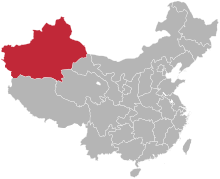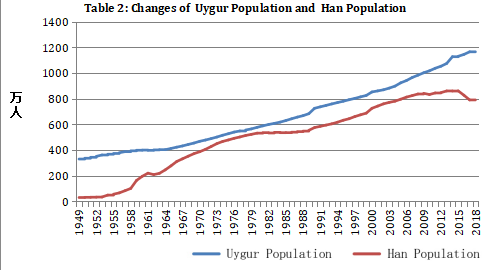Xinjiang Uygur Autonomous Region: Difference between revisions
mNo edit summary Tag: Visual edit |
No edit summary Tag: Visual edit |
||
| Line 1: | Line 1: | ||
{{Infobox settlement|conventional_long_name=Xinjiang Uygur Autonomous Region|native_name=新疆维吾尔自治区<br>شىنجاڭ ئۇيغۇر ئاپتونوم رايونى|image_map=Xinjiang map.svg|image_map_size=220px|capital=Ürümqi|largest_city=Ürümqi|settlement_type=Autonomous region|leader_title1=Party Secretary|leader_name1=Ma Xingrui|leader_title2=Standing Committee Director|leader_name2=Xiaokaiti Yiming|leader_title3=People's Government Chair|leader_name3=Erkin Tuniyaz|population_estimate=25,852,300|population_estimate_year=2020|GDP_nominal=USD $215.63 billion|area_km2=1,664,897|official_languages=Chinese<br>Uyghur}} | {{Infobox settlement|conventional_long_name=Xinjiang Uygur Autonomous Region|native_name=新疆维吾尔自治区<br>شىنجاڭ ئۇيغۇر ئاپتونوم رايونى<br>xīn jiāng wéi wú ěr zì zhì qū|image_map=Xinjiang map.svg|image_map_size=220px|capital=[[Ürümqi]]|largest_city=[[Ürümqi]]|settlement_type=Autonomous region|leader_title1=Party Secretary|leader_name1=Ma Xingrui|leader_title2=Standing Committee Director|leader_name2=Xiaokaiti Yiming|leader_title3=People's Government Chair|leader_name3=Erkin Tuniyaz|population_estimate=25,852,300|population_estimate_year=2020|GDP_nominal=USD $215.63 billion|area_km2=1,664,897|official_languages=Chinese<br>Uyghur}} | ||
The '''Xinjiang Uygur Autonomous Region''' (Chinese: 新疆维吾尔自治区), also known as '''Xinjiang''' (新疆) or '''XUAR''' is an autonomous region of [[People's Republic of China|China]]. It is a vast region with a very low population density. It contains the Karakoram, Kunlun and Tian Shan mountain ranges, as well as the Taklamakan Desert. | The '''Xinjiang Uygur Autonomous Region''' (Chinese: 新疆维吾尔自治区), also known as '''Xinjiang''' (新疆) or '''XUAR''' is an autonomous region of [[People's Republic of China|China]]. It is a vast region with a very low population density. It contains the Karakoram, Kunlun and Tian Shan mountain ranges, as well as the Taklamakan Desert. | ||
| Line 22: | Line 22: | ||
== Economy == | == Economy == | ||
The GDP of Xinjiang rose from 539.7 to 1,379.8 yuan between 2010 and 2020.<ref name=":1" /> | The [[GDP]] of Xinjiang rose from 539.7 to 1,379.8 yuan between 2010 and 2020.<ref name=":1" /> | ||
== References == | == References == | ||
| Line 29: | Line 29: | ||
[[Category:People's Republic of China]] | [[Category:People's Republic of China]] | ||
[[Category:Debunking myths]] | [[Category:Debunking myths]] | ||
[[Category:Provinces of China]] | |||
Revision as of 00:05, 12 February 2023
Xinjiang Uygur Autonomous Region 新疆维吾尔自治区 شىنجاڭ ئۇيغۇر ئاپتونوم رايونى xīn jiāng wéi wú ěr zì zhì qū | |
|---|---|
Autonomous region | |
 | |
| Capital and largest city | Ürümqi |
| Official languages | Chinese Uyghur |
| Government | |
• Party Secretary | Ma Xingrui |
• Standing Committee Director | Xiaokaiti Yiming |
• People's Government Chair | Erkin Tuniyaz |
| Area | |
• Total | 1,664,897 km² |
| Population | |
• 2020 estimate | 25,852,300 |
| GDP (nominal) | estimate |
• Total | USD $215.63 billion |
The Xinjiang Uygur Autonomous Region (Chinese: 新疆维吾尔自治区), also known as Xinjiang (新疆) or XUAR is an autonomous region of China. It is a vast region with a very low population density. It contains the Karakoram, Kunlun and Tian Shan mountain ranges, as well as the Taklamakan Desert.
History
Ancient history
Xinjiang became part of the Han dynasty in 60 BCE. The region has been populated by Han Chinese since this time.
The Uygurs are the descendants of the nomadic Dingling (丁零) tribe in Mongolia. In 552 CE a clan of the emerging Dingling tribe established a Turkic Khanate in the Dunggar Basin in northern Xinjiang. In 744, the Uygur Alliance led by Guli Pei Luo, with the cooperation of the army of the Tang Dynasty, overthrew the Turkic Khanate and established the Mobei Uyghur Khanate.
Chinese Civil War
Uyghur separatists founded an Islamic state in Xinjiang in the 1930s shortly after the Japanese invasion of Manchuria.[1]
Terrorism
In 1990, the East Turkestan Islamic Movement organized its first terrorist attack in Baren Township. The ETIM was designated as a terrorist organization by the UN in 2002 and by the Chinese government in 2003. In July 2009, Islamic extremists caused riots in Ürümqi, killing almost 200 people and injuring over 1,000. In May 2014 in Ürümqi, they drove cars into a crowded marketplace and threw explosives at buildings, killing 39 and injuring 94. In July 2014, Imam Juma Tahir was assassinated after calling for peace and stability in Xinjiang.[2]
Similar to Operation Cyclone, where the USA supported Islamic fundamentalism to destabilize the socialist government of Afghanistan, the US has supported Islamic fundamentalist separatists in the Xinjiang region of China. China's response to this upsurge of terrorism and separatism has been to construct re-education camps which have been decried by the Western press in an effort to accuse China of running "concentration camps" and "death camps." Western countries have signed a letter criticizing China, while a counter-letter was signed by countries in the Muslim World as well as progressive states such as Cuba and Bolivia (under the socialist government of Evo Morales, prior to the US-backed coup)[2][3]
Demographics

Today in the Xinjiang there are 12.7 million Uygurs, and 9 million Han, and 3.1 million people in other ethnic groups, or 51%, 36%, and 13% respectively.[4] The population has doubled since 1978, and the Uyghur population increased by more than 5.6 million in the same time period.[1]
Economy
The GDP of Xinjiang rose from 539.7 to 1,379.8 yuan between 2010 and 2020.[1]
References
- ↑ 1.0 1.1 1.2 "Xinjiang and the Uyghur Question" (2022-09-28). Australian Marxist Review. Retrieved 2022-11-27.
- ↑ 2.0 2.1 "Xinjiang: A Report and Resource Compilation" (2021-09-21). Qiao Collective. Archived from the original on 2022-06-20. Retrieved 2022-06-24.
- ↑ "Beijing’s Decades-Long Policies in Xinjiang, CIA Interference, Funding of Separatist and Terrorist Groups" by the Orinoco Tribune
- ↑ China Daily (2021) An Analysis Report on Population Change in Xinjiang